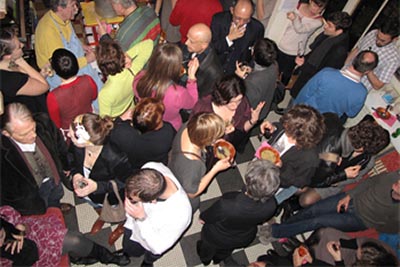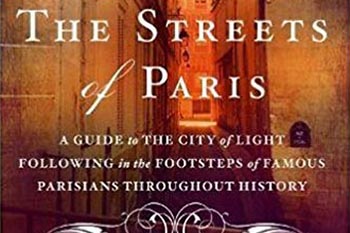
Inside Out: A Sampling of Paris’ Spectacular Green Spaces
By Faye Wolfe
Senior Writer

There are many reasons to be inside in Paris—dozens of museums, 400-plus Michelin-starred restaurants, stellar department stores, and specialty shops—but insiders know that the city’s green spaces are equally irresistible.
Besides being plentiful and beautiful, most of them are free and open to the public, great for travelers on a budget. Parisian parks and gardens are also terrific places to relax, regroup, and, on sunny days, reset your inner clock to stave off jet lag.
The Luxembourg Garden, the Tuileries, and the Bois de Boulogne are among Paris’ most famous parks; others well worth seeing are less known.
A friend, a travel writer who has visited Paris frequently for 60 years, told me she had never been to the Jardin des Plantes.
Paris’ Cultivated Gardens
For centuries, Parisian landscape designers have heeded Voltaire’s advice to “cultivate your garden,” creating highly civilized versions of the Great Outdoors that are attractive all year round.
In fall, the leaves on the trees gleam gold and bronze. The city’s parks and gardens have, by one tally, 36,500 trees. That’s a lot of foliage.
In winter and early spring, the architectural elements, the spare, elegant layouts, and the contours of the trees come to the fore.
One of my most memorable experiences in the City of Light was a December visit to the Musée Rodin. Under moody, broody skies, with a chill in the air, the gardens looked far more romantic and atmospheric than they would have on a sunny July day.
Still, traveling to the French capital in October, I had modest expectations. Assuming that most of the flowering plants had run their course, I was pleased to see the show was still going on. The balmy weather during my stay added to the illusion that it was still high season.
A Garden of Plants
On my first morning in the city, at 10 a.m. Paris time, 4 a.m. my time, I made my groggy way to the Jardin des Plantes, one of the world’s premier botanical sites, just a 10-minute walk from my hotel, the Serotel Lutèce. It was like stepping inside a dream.
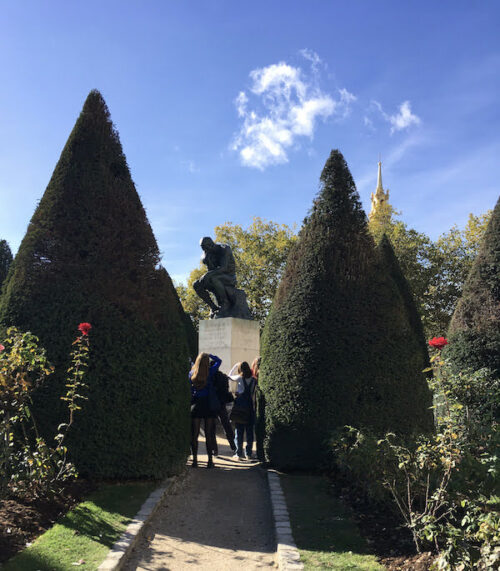
The beds were a riotous but artful display of vermilion canna, violet monkshood, mauve verbena, blue salvia, black-eyed Susans, coppery ornamental grasses, poppies and dahlias in a panoply of colors, and more. (According to the garden’s website, more than 700 plant varieties bloom from June into fall.)
Morning glories in profusion fluttered on seven-foot-tall circular trellises. The rose garden was winding down, but I found choice blossoms on many of the modern and heirloom species and varieties.
Located in the fifth arrondissement, the Jardin’s roots go down nearly four centuries. In 1635, King Louis XIII decreed that a garden be established, on this doctor’s advice, as a place for growing herbs and instructing medical students in their use. From the beginning, it was open to the public.
Early specimens included coffee plants, pistachio trees, and a cedar of Lebanon planted in 1734 and still standing tall today. Legend has it that eminent botanist Bernard de Jussieu brought the cedar seedling to Paris from England in his hat after its pot broke.
The Jardin is really a set of gardens, including the Alpine Garden, the Garden of Useful Plants, and the Ecological Garden (access via guided tours only), with massive greenhouses, a maze, and a zoo also on the premises. In turn, the Jardin des Plantes is part of the National Museum of Natural History.
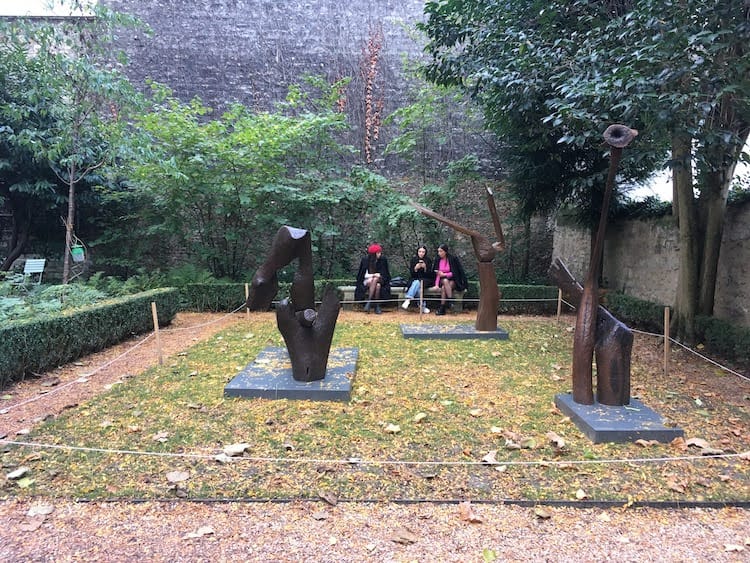
Sharing the site, monumental 19th-century buildings house the Grand Gallery of Evolution, the Paleontology and Comparative Anatomy Gallery, and the Geology and Mineralogy Gallery. Their holdings are spectacular: Life-size elephant models! Dinosaur skeletons! Meteors from Mars!
That first morning, though, I was content to stroll the gravel paths, admiring the flowers, the towering hedges, and the mottled trunks of the plane trees, then plop down on a bench. Nearby, toddlers “planted” sticks in the ground. Two little boys were deep into an imaginative adventure.
Chic grandmothers kept an eye out. A school field trip came through. A pack of runners did laps around the 480-meter walkway. A coven of Goths studied their phones. A gray-haired man fed pigeons. Office workers unwrapped their lunches. I was reminded that sometimes, the best thing to do when you travel is nothing, nothing but observe the life all around you.
Sculptures en plein air
Whatever part of the Musée Rodin’s seven acres of green space you gravitate to, you’ll find a spot to match your mood. The magnificent grounds, in the heart of the city, have both formal and naturalistic gardens. Dozens of rose bushes in garden beds bracket the front cobblestone courtyard.
Boxwood cones, with nary a leaf out of place, enshrine The Thinker, perhaps Rodin’s most famous work. An axial garden framed by linden trees and broad flower borders, extends from the rear terrace of the l’Hôtel Biron to a circular pool.
Past the marble galleries, in the sous-bois, you almost expect to see “innocent rabbits,” as did the poet Rainer Maria Rilke, Rodin’s secretary 100-odd years ago. Instead, tourists snap photos of more statues among the trees.
The 18th-century Hôtel Biron, home at various times to dukes, schoolgirls, and Isadora Duncan, is a gorgeous, light-filled setting for the many art treasures on exhibit. (“Hotel” in this case is hôtel particulier, a private mansion.)
Often called the father of modern sculpture, Auguste Rodin lived here from 1911 until his death in 1917. From its windows, you’ll catch enticing views of the gardens.
But if you’re pressed for time (and what traveler isn’t?) or just experiencing museum fatigue, you might skip the Biron and instead get closer up to the gardens. Besides The Thinker, The Gates of Hell, Monument to Balzac, and other major works are displayed to maximum dramatic effect.
Having seen a beautifully curated Rodin exhibition recently, I still think nothing beats seeing his work in this outdoor setting. The gardens’ free-form and highly groomed elements complement the sculptures, themselves often a hybrid of the rough and the smooth. (The Musée Rodin is located at 77 rue de Varenne, in the seventh arrondissement.)
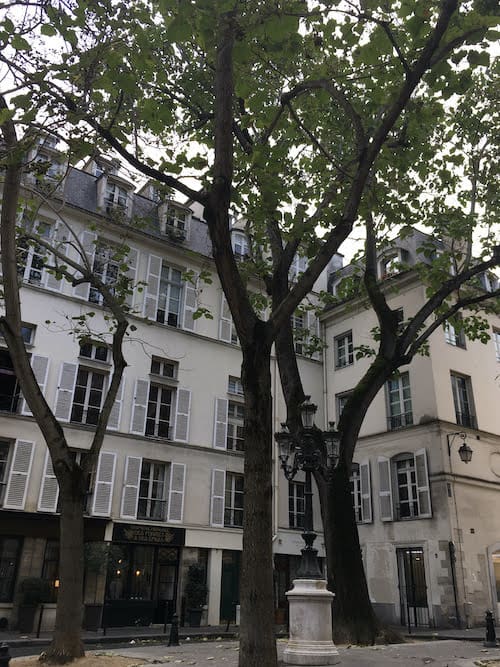
Speaking of Artists’ Gardens…
“I felt slightly melancholic after dinner to find myself uprooted once more. I gradually became reconciled with the idea and went to bed delighted … The view of my little garden and the cheerful appearance of my studio always make me happy.”
The celebrated French Romantic painter Eugène Delacroix was speaking of moving house, but he could have been describing the mood swings travelers sometimes experience in a new place.
Seeing his garden, studio and apartment, which now comprise the Musée national Eugène Delacroix, made me very happy.
It’s off a lovely little square, the Place de Furstemberg, in the seventh arrondissement, a stone’s throw from that famous writers’ and artists’ hangout Les Deux Magots.
Unlike Rodin’s former digs, the museum is not grand, but delightful nonetheless. The apartment is now a set of galleries exhibiting Delacroix’s works and those of his fans, of which he had many during his lifetime and after.
In fact, in 1929, it was the Society of Friends of Eugene Delacroix who successfully prevented the building’s being razed, and the garden uprooted, to make way for a parking garage.
An outdoor stairway connects the apartment to the studio, an inspiring space overlooking Delacroix’s “little garden.”
Petite it is, yet within its walls are several fruit trees, a tall tree encircled by a bench, flower beds, and a patch of emerald lawn.
Spared uprooting, the garden was redone sensitively a few years ago: You can almost imagine the artist daydreaming on a pale green chair. The serene ambiance was enhanced when I was there by the quiet, evocative carved wood sculptures of American artist Thaddeus Mosley, part of Paris+ par Art Basel.
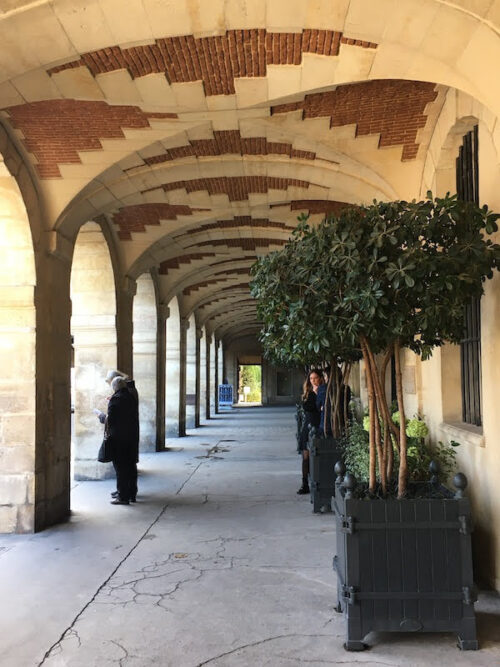
Place des Vosges
Built in the early 1600s, the Place des Vosges, in the fourth arrondissement, was conceived by King Henri IV as an incubator project to develop a silk industry in France. That initiative never got off the ground.
Instead, the brick-and-stone pavilions forming a square around a park “immediately became the center of the city’s fashionable society,” according to Paris Through the Ages.
Galleries, restaurants, and shops open off the building’s arcades. Like a square-cut emerald, a park occupies the center of the Place.
With its high, ornamental fence two wide walkways at right angles, and two narrower diagonal paths, the park is very French, very formal, its use, informal.
People sunbathe on the lawns on warm days or lounge on benches beneath the central cluster of horse chestnut trees and the clipped lindens on the perimeter. It’s a perfect spot for a pique-nique.
A Secret Garden
Beyond a doorway, in the southwest corner of the Place des Vosges, lies a garden, part of the landmark Hôtel de Sully, once the private mansion of the Le Duc de Sully, now the headquarters of the Center of National Monuments.
Hardly a secret garden, but coming upon it feels like a discovery. (A woman 20 steps ahead of me let out a little gasp as she went through the open door.)
On the near and far sides are two exquisite buildings. At the Place des Vosges end is the former orangery, which once sheltered citrus trees in winter.

Parterres enclosed by low box hedges end in a stone balustrade and cobblestone paving that leads to the second building, ornamented by bas reliefs of women symbolizing spring and summer. (Don’t miss the stone lobster over Summer’s head.)
My favorite part of the garden was a tree with an enormous canopy, an old soul, by one wall.
A second, paved courtyard, reached through a short, arched passageway, has no greenery, just a buxom sphinx, but the bookstore on the far side of the court has an extensive collection of books about aspects of French culture.
The garden has closed for renovations that include adding four orange tree standards. (Le Duc would approve.) The work will be completed in early 2023, and the bookstore remains open.
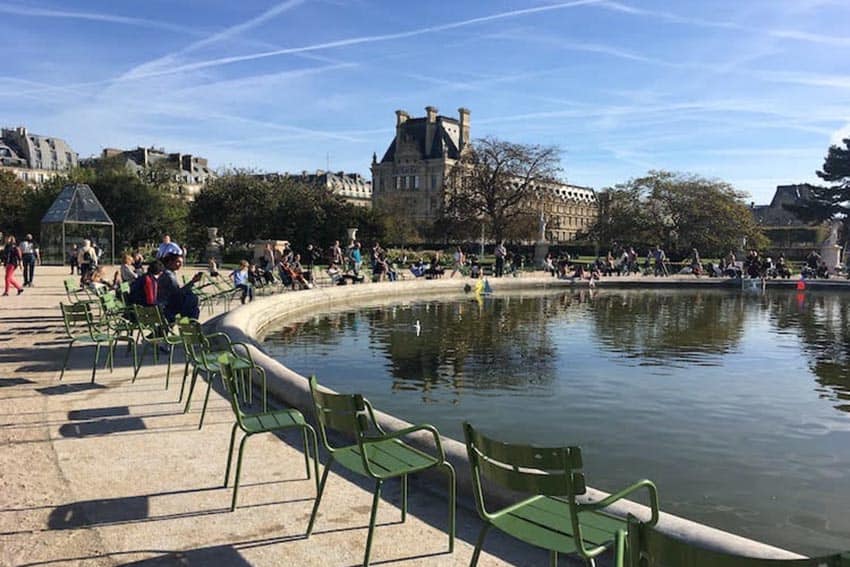
Jardin des Tuileries
Like the Place des Vosges, the Tuileries was originally a workplace. In 1564, Queen Catherine de Medici had the tile factories cleared away and built a palace with an Italian garden. A century later, after a flood, André le Nôtre, designer of the gardens of Versailles, was charged with restoring the garden, and his design remains largely intact.
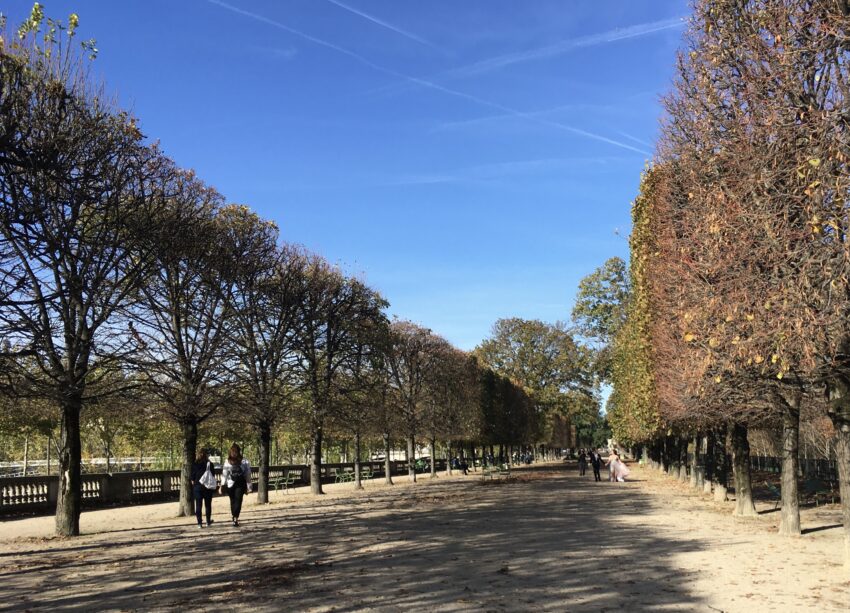
Le Nôtre came to his trade naturally. His father and grandfather were Tuileries gardeners, and he was born and died in a house on the premises.
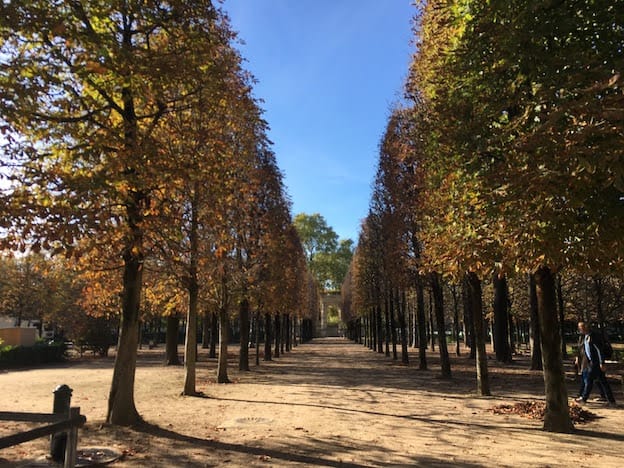
Footsteps away from such major attractions as the Louvre and the Place de Concorde, the Tuileries itself plays host to millions every year, tourists and natives, even hardy souls who jog its snowy paths in winter. One of the first public gardens in Europe, its long allées.
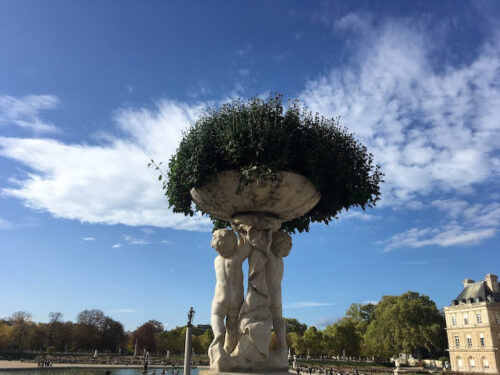
Manet, Monet, Pissarro, Eugène Atget, and André Kertész are among the artists who found it inspiring; another famous admirer was Thomas Jefferson, who soared above its trees in a hot-air balloon in 1784.
Art lovers can seek out sculptures by Maillol, Rodin, and Giacometti or recline in a little green chair by the fountains, before or after tackling the Louvre’s infinite halls.
Bouquets and sachets
Neither park nor garden, the 200-year-old Marché aux Fleurs Reine Elizabeth II, in the fourth arrondissement, is a lovely green space all the same. Not far from Notre Dame, in the Place Louis Lépine, vendors sell bouquets, orchids and cacti, bulbs, shrubs, and more.
The colors, the scents, the history: there’s something about it that goes straight to the heart. Chances are, you won’t be picking up an azalea to bring home, but the fragrant lavender sachets on sale there make wonderful souvenirs.
- Paris: Getting to the Famous Gardens - January 13, 2023
- The Eric Carle Museum for Children and Illustrators - July 19, 2020
- A Blissful Family Vacation in Santa Rosa, California - June 8, 2019






